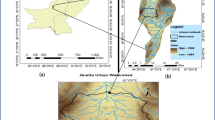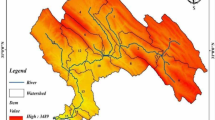Abstract
The applicability of artificial neural networks (ANN), adaptive neuro-fuzzy inference system (ANFIS), and genetic programming (GP) techniques in estimating soil temperatures (ST) at different depths is investigated in this study. Weather data from two stations, Mersin and Adana, Turkey, were used as inputs to the applied models in order to model monthly STs. The first part of the study focused on comparison of ANN, ANFIS, and GP models in modeling ST of two stations at the depths of 10, 50, and 100 cm. GP was found to perform better than the ANN and ANFIS-SC in estimating monthly ST. The effect of periodicity (month of the year) on models’ accuracy was also investigated. Including periodicity component in models’ inputs considerably increased their accuracies. The root mean square error (RMSE) of ANN models was respectively decreased by 34 and 27 % for the depths of 10 and 100 cm adding the periodicity input. In the second part of the study, the accuracies of the ANN, ANFIS, and GP models were compared in estimating ST of Mersin Station using the climatic data of Adana Station. The ANN models generally performed better than the ANFIS-SC and GP in modeling ST of Mersin Station without local climatic inputs.













Similar content being viewed by others
References
Anderson JE, McNaughton SJ (1973) Effects of low soil temperature on transpiration, photosynthesis, leaf relative water content, and growth among elevationally diverse plant populations. Ecology 54:1220–1233
Bae DH, Jeong DM, Kim G (2007) Monthly dam inflow forecasts using weather forecasting information and neuro-fuzzy technique. Hydrol Sci J 52(1):99–113
Citakoğlu H, Cobaner M, Haktanir T, Kisi O (2014) Estimation of monthly mean Reference evapotranspiration in Turkey. Water Resour Manag 28:99–113
Cobaner M (2013) Reference evapotranspiration based on class a pan evaporation via wavelet regression technique. Irrig Sci 2:119–134
Cobaner M (2011) Evapotranspiration estimation by two different neuro-fuzzy inference systems. J Hydrol 398(3–4):292–302
Cobaner M, Citakoglu H, Kisi O, Haktanir T (2014) Estimation of mean monthly air temperatures in turkey. Comput Electron Agric 109:71–79
Creamer FL, Fox RH (1980) The toxicity of banded urea or diammonium phosphate to corn as influenced by soil temperature, moisture, and pH. Soil Sci Soc Am J 44:296–300
Du K-L, Swamy MNS (2006) Neural networks in a soft computing framework. Springer, London
Goldberg DE (1989) Genetic algorithms in search, optimization and machine learning. Addison-Wesley Longman Publishing Co., Inc, Boston, MA, USA.
Hasanuzzaman, M., Nahar, K., and Fujita, M. 2013. Extreme temperature responses, oxidative stress and antioxidant defense in plants, abiotic stress-plant responses and applications in agriculture, Dr. Kourosh Vahdati (Ed.), ISBN: 978–953–51-1024-8, InTech, doi:10.5772/54833.
Kim S, Singh VP (2014) Modeling daily soil temperature using data-driven models and spatial distribution. Theor Appl Climatol 118:465–479
Kisi O, Shiri J (2014) Prediction of long-term monthly air temperature using geographical inputs. Int J Climatol 34(1):179–186
Kisi O (2008) River flow forecasting and estimation using different artificial neural network techniques. Hydrol Res 39(1):27–40
Kisi O, Sanikhani H (2015) Prediction of long-term monthly precipitation using several soft computing methods without climatic data. Int J Climatol. doi:10.1002/joc.4273
Kisi O, Tombul M, Zounemat-Kermani M (2015) Modeling soil temperatures at different depths by using three different neural computing techniques. Theor Appl Climatol 121:377–387
Labanauskas CK, Stolzy LH, Luxmoore RJ (1975) Soil temperature and soil aeration effects on concentration and total amounts of nutrients in “Yecora” wheat grain. Soil Science Baltimore 120(6):450–454.
Rahimikhoob A (2010) Estimation of evapotranspiration based on only air temperature data using artificial neural networks for a subtropical climate in Iran. Theor Appl Climatol 101:83–91
Rezaeian-Zadeh M, Zand-Parsa S, Abghari H, Zolghadr M, Singh VP (2012) Hourly air temperature driven using multi-layer perceptron and radial basis function networks in arid and semi-arid regions. Theor Appl Climatol 109:519–528
Rosenzweig C, Liverman D (1992a) Predicted effects of climate change on agriculture: a comparison of temperate and tropical regions. In: Majumdar SK (ed) Global climate change: implications, challenges, and mitigation measures. The Pennsylvania Academy of Sciences, PA, pp. 342–361
Rosenzweig, C., and D. Liverman. 1992b. Predicted effects of climate change on agriculture: a comparison of temperate and tropical regions. In Global climate change: implications, challenges, and mitigation measures, ed. S. K. Majumdar, 342–61. PA: The Pennsylvania Academy of Sciences, Pittsburgh.
Sanikhani H, Kisi O (2012) River flow estimation and forecasting by using two different adaptive neuro-fuzzy approaches. Water Resour Manag 26(6):1715–1729
Sudheer KP, Gosain AK, Ramasastri KS (2003) Estimating actual evapotranspiration from limited climatic data using neural computing technique. J Irrig Drain Eng 129(3):214–218
Swank WT, Vose JN (1988) Effects of cutting practices on microenvironment in relation to hardwood regeneration. In: Smith HC, Perkey AW, Kidd Jr. WE (eds) Guidelines for Regenerating Appalachian Hardwood Stands, SAF Publ. 88-03. West Virginia University Books, Morgantown, pp 71–88
Tabari H, Sabziparvar AA, Ahmadi M (2011) Comparison of artificial neural network and multivariate linear regression methods for estimation of daily soil temperature in an arid region. Meteor Atmos Phys 110:135–142
Trajkovic (2010) Testing hourly reference evapotranspiration approaches using lysimeter measurements in a semiarid climate. Hydrol Res 41(1):38–49
Trajkovic S, Stankovic M, Todorovic B (2000) Estimation of FAO Blaney-Criddle b factor by RBF network. J Irrig Drain Eng 126(4):268–271
Author information
Authors and Affiliations
Corresponding author
Rights and permissions
About this article
Cite this article
Kisi, O., Sanikhani, H. & Cobaner, M. Soil temperature modeling at different depths using neuro-fuzzy, neural network, and genetic programming techniques. Theor Appl Climatol 129, 833–848 (2017). https://doi.org/10.1007/s00704-016-1810-1
Received:
Accepted:
Published:
Issue Date:
DOI: https://doi.org/10.1007/s00704-016-1810-1




